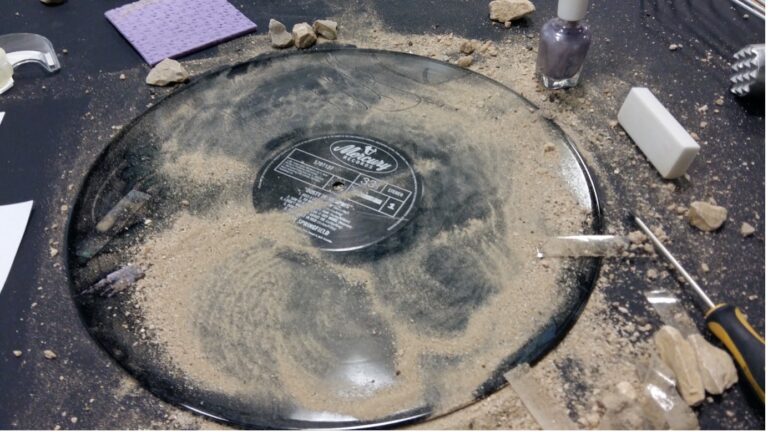Artist Statement: Summary of Artistic Work and Research
I have always been interested in fragments.
My practice and research are interdisciplinary, lying at the intersection between music performance, musicology, composition, post-structural philosophy, and the visual arts. Research projects focus upon 20th and 21st century music, with a particular emphasis on indeterminacy, modes of improvisation and the experimental tradition. Currently, I am working on three albums—music by Michael Finnissy, John Cage and Hans Joachim Hespos—and two books exploring the themes of hauntology in mid-century music (part of Cambridge University Press’ ‘Elements of music Since 1945’ series) and radio as agent of radical decentering (Palgrave Macmillan). I work with live and recorded performance and composition, writing, installations, exhibition and artworks, across a range of technologies, techniques and modes of dissemination. I enjoy challenging traditional forms of music scholarship, forging new creative strategies and modes of expression whenever possible.

Although I gained my PhD in music in 2021, my research journey really began more than fifteen years earlier with a chance encounter with Jacques Derrida’s (1930-2004) Glas (1974); a text that would become pivotal to much of my subsequent work. The unorthodox layout and approach to philosophy and literature offered by Derrida in Glas was intriguing and compelling. Its use of intertextuality, its meanings within meanings and cross references presented philosophy in a completely new way for me. After this encounter, concepts of narrative time in my work morphed into what Derrida called a ‘series of modalized presents,’ and my performance, musicology and composition came together in an intricate pattern of ceaseless, interlinked movement, each new work informing the others and adding to an endlessly reforming fabric. My research began to take the form of a grid or map, with each node or ‘place’—whether a recital, written text, canvas, composition, sculpture, or recording—being connected to the others, yet retaining its singularity. Thus began a long process of decentering and fragmentation, opening possibilities for constant movement, opening new perspectives as I move along the threads of my research.

Since that pivotal moment, the grid has grown exponentially; performances of Cage and Finnissy interpenetrate with the work of Sun Ra and The Caretaker; Derrida’s Archive Fever informs an understanding of Christian Marclay and vice versa; through decentering and hauntology, Stockhausen’s radio and tape works intersect with the legacy of empire and contemporary climate change. The map is drawn though a landscape of generative documents in sound and virtual ink. As Derrida remarks:
The meaning of “grid” does not achieve assembled totality. It crosses through. To establish a grid is to cross through, to go through a channel. It is the experience of permeability…such a crossing does not move through an already existing-texture; it weaves this texture, it invents the histological structure of a text of what one would call in English a “fabric.”

Combining musicology, performance, and composition, these three domains often come together in artistic research endeavours. As a crucible of experimentation, artistic research opens multiple, interlinked and interdisciplinary fields of problematicity. Encompassing areas of HIP, HIPEX, organology, recording and archiving, hermeneutics, curation, and technology (to name but a few), and working with a considerable choice of texts (including scores, recordings and commentaries) from all time periods, musical styles and cultures, the research field is wide open to engage with diverse practices and practitioners. Looking for opportunities to present this diversity prompted me to found ElectroFest at New York University Abu Dhabi, the UAE’s first interdisciplinary festival of electroacoustic and experimental music. Since 2018, students, faculty, staff and guests have showcased and discussed diverse examples of artistic research, composition and contemporary music performance, ranging from ludo music and film scores to real-time DAW improvisation, electro classics from the 1960s and 1970s and newly composed pieces spanning the fields of music, robotics, film, theatre and sculpture.

I have presented my research in conference papers and publications across a diverse array of topics including: deconstruction and Afro-Futurism in the work of Sun-Ra; digital performance; deconstruction, indeterminacy and architecture; the rehearsal process; hauntological and hypnagogic pop; the archive; Christian Marclay; the music of John Cage, Hans Joachim Hespos, Michael Finnissy, and Karlheinz Stockhausen; deconstruction and the visual arts; hauntology and ecomusicology. My research also engages with music and pragmatism, hermeneutics, co-operative networks in group performance projects, music and the environment and the interpretation of non-standard notation. Decentering and fragmentation are key themes across all of my outputs. My projects, in practice and theory, are the result of extended and multi-faceted research processes, drawing on numerous strands of ideas and finding their final synthesis across a network of connected outputs, thus, each project is both a summation and a new beginning; they do ‘not achieve assembled totality’ but instead work to generate new ‘fabric.’

As a music practitioner, I have performed internationally as a singer specialising in contemporary music (with and without electronics) for over twenty years, and performance is integral to much of my research. I am particularly interested in performing works that utilise indeterminacy, graphic notation, improvisation and live technology and I have made a special focus on analogue technology in music (radio, tape and LPs), musical obsolescence (signals and equipment) as well as contemporary tools such as Ableton live, in performance. As well as performing experimental and virtuosic repertoire, I also regularly program standard 19th and 20th century works, including Lieder, Chansons and English art song. I often collaborate with visual artists, and in two recent compositions—Logosphere (2022) and Ghost Gardens (2023)—I worked with light artist Simon Fraulo and filmmaker Alia Yunis. I have recorded and worked with established and new generation composers, such as Karlheinz Stockhausen, Charlotte Seither, Heinz Holliger, Shu Yu Lin, Michael Finnissy, Hans Joachim Hespos, Sxip Shirey, and Kacper Madejek. This experience has informed my continuing researches into the composer/performer interface, recorded acts and acts of recording. I have introduced contemporary and experimental repertoire to the UAE through many concerts as a performer and composer where I have given numerous regional premieres.
